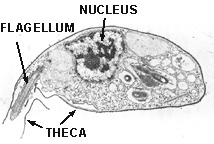Apusomonads
Apusomonadidae
David J. PattersonIntroduction
The apusomonads (also called thecamonads) include two genera and about 10 species of small gliding flagellates. They occur in soils, freshwater and marine habitats and have a world-wide distribution. They are tectic organisms inasmuch as they are associated with surfaces (of particles, of sediment or of detritus such as dead dogs). They can be common and abundant. They consume bacteria, often using pseudopodia which emerge from the ventral face of the cell to do so. The genera were grouped into an order - the Apusomonadida by Karpov and Mylnikov in 1991.
Characteristics


Transmission electron micrograph of Amastigomonas debruynei. The anterior of the cell, with the projecting flagellum, is to the left. The illustration shows the organic layer which is attached to the cell and lies around the flagellum.
Micrograph copyright © 2000 David J. Patterson.
Apusomonads are flagellates with tubular mitochondrial cristae. They are distinguished from other tubulocristate flagellates by the presence of a flexible organic lorica or theca which lies over the dorsal face of the cell and ensheaths the basal part of the anterior flagellum. Apusomonads have two flagella, the first extends anterior or anterio-laterally, the second trails behind the cell. The two basal bodies insert almost at right angles and give rise to four microtubular roots, two of which determine the margins of the ventral face of the cell.
Discussion of Phylogenetic Relationships
The two genera of apusomonads are regarded as sister taxa because all studied representatives of both genera have an external theca. The synapomorphy of the genus Apusomonas is the mastigophore - the anterior projection into which the anterior flagellum inserts. This trait is not seen in any other taxa and is believed to be derived. The genus Amastigomonas may be paraphyletic since there are no known synapomorphies for the five species contained within this group.
References
Cavalier-Smith, T. and Chao, E.E. 1995. The opalozoan Apusomonas is related to the common ancestor of animals, fungi and choanoflagellates. Proceedings of the Royal Society of London, B, 261: 1-6.
Ekelund, F. and Patterson, D.J. 1997. Some flagellates from a cultivated garden soil in Australia. Archiv fur Protistenkunde 148: 461-478.
Karpov S. A. & Mylnikov A. P. 1989. Biology and ultrastructure of colourless flagellates Apusomonadida ord. n. Zoologischkei Zhurnal 58: 5-17. (in Russian)
Molina, F. I. and Nerad, T. A. 1991, Ultrastructure of Amastigomonas bermudensis ATCC 50234 sp.nov. - a new heterotrophic marine flagellate, European Journal of Protistology, 27, 386-396.
Patterson, D. J. 1999. The diversity of eukaryotes. American Naturalist 154: S96-124.
Title Illustrations

| Scientific Name | Amastigomonas debruynei |
|---|---|
| Specimen Condition | Dead Specimen |
| Image Use |
 This media file is licensed under the Creative Commons Attribution License - Version 3.0. This media file is licensed under the Creative Commons Attribution License - Version 3.0.
|
| Copyright |
© 2000 David J. Patterson

|
About This Page
David J. Patterson

Marine Biological Laboratory, Woods Hole, Massachusetts, USA
Correspondence regarding this page should be directed to David J. Patterson at
Page copyright © 2009 David J. Patterson
 Page: Tree of Life
Apusomonads. Apusomonadidae .
Authored by
David J. Patterson.
The TEXT of this page is licensed under the
Creative Commons Attribution License - Version 3.0. Note that images and other media
featured on this page are each governed by their own license, and they may or may not be available
for reuse. Click on an image or a media link to access the media data window, which provides the
relevant licensing information. For the general terms and conditions of ToL material reuse and
redistribution, please see the Tree of Life Copyright
Policies.
Page: Tree of Life
Apusomonads. Apusomonadidae .
Authored by
David J. Patterson.
The TEXT of this page is licensed under the
Creative Commons Attribution License - Version 3.0. Note that images and other media
featured on this page are each governed by their own license, and they may or may not be available
for reuse. Click on an image or a media link to access the media data window, which provides the
relevant licensing information. For the general terms and conditions of ToL material reuse and
redistribution, please see the Tree of Life Copyright
Policies.
- First online 18 September 2000
Citing this page:
Patterson, David J. 2000. Apusomonads. Apusomonadidae . Version 18 September 2000. http://tolweb.org/Apusomonads/2387/2000.09.18 in The Tree of Life Web Project, http://tolweb.org/











 Go to quick links
Go to quick search
Go to navigation for this section of the ToL site
Go to detailed links for the ToL site
Go to quick links
Go to quick search
Go to navigation for this section of the ToL site
Go to detailed links for the ToL site